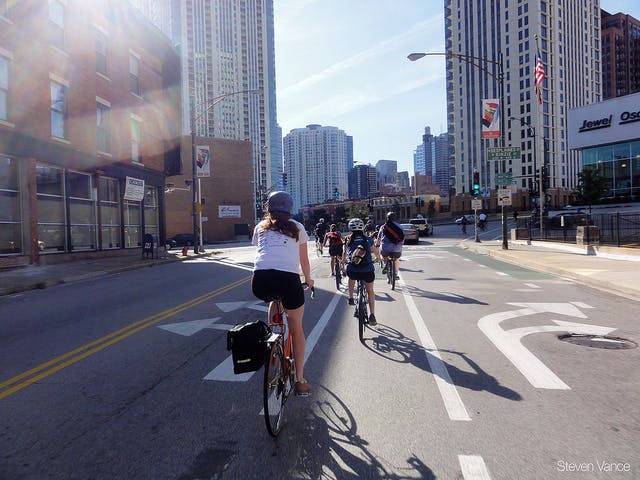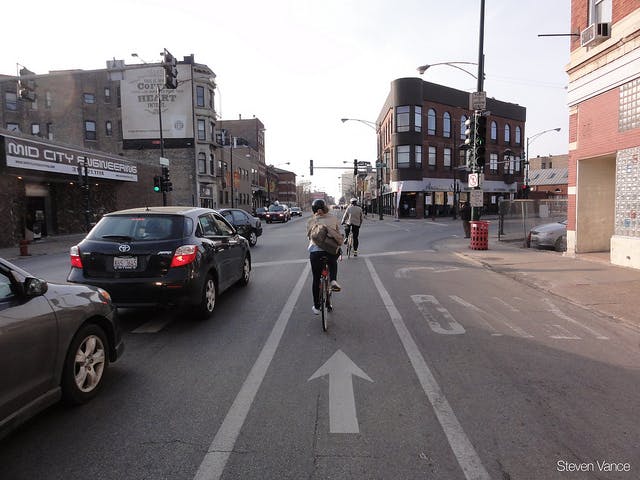Explore Our Network of Sites
Search
By:

The Chicago Department of Transportation has added many miles of protected and buffered bike lanes across the city, but it can be challenging to find space for protected lanes on the streets where they are needed the most. CDOT has implemented ?road diets? on several streets, replacing excess car lanes with protected lanes, which has the added benefit of reducing speeding and shortening pedestrian crossing distances. The Dearborn two-way protected bike lane, through the heart of the Loop, is the most notable example of this tactic.
Now CDOT is considering taking a somewhat bolder step by removing parking on sections of Milwaukee Avenue, Chicago’s busiest bike street, to make room for protected lanes between Elston Avenue and Kinzie Street. Milwaukee’s junctures with North and Chicago avenues are two of the city’s intersections with the most bike crashes, so protection from car traffic would be a huge benefit for cyclists. This stretch of Milwaukee also serves as a connector between existing protected lanes on Elston and Milwaukee.
However, CDOT project manager Mike Amsden explained that because this segment of Milwaukee is 50-to-52-feet-wide and has significant bus and truck traffic, it’s considered too narrow for both protected lanes and parking lanes on each side. On a 52-foot roadway you can fit ten-foot travel lanes, eight-foot parking lanes, a three-foot buffer and five-foot bike lanes, but that’s pretty tight for a street with heavy truck and bus traffic, he said. He added that there are currently so many bike riders on Milwaukee that wider bike lanes are needed so that faster cyclists have plenty of room to pass slower ones.
Amsden said his agency is looking at ?consolidating? the parking on this stretch, removing a parking lane on one side of the street in sections where there is low demand, in order to make room for wider travel lanes and protected bike lanes. If a parking lane is removed on Milwaukee, which is largely unmetered, CDOT may convert some of the wider side streets from parallel to diagonal parking to create additional spaces. ?We?re doing a lot of parking observation right now and talking to businesses to find out how they currently use parking and loading zones,? Amsden said. ?On stretches where we can’t take out parking for a protected lane we?d put in a nice, wide buffered bike lane.?
CDOT has also been in talks with the local chambers of commerce and 27th Ward Alderman Walter Burnett‘s office; staffers will be meeting with Burnett next week. Burnett’s assistant Jesse Ech seemed skeptical that removing any parking spaces is a good idea. ?We?re trying to keep parking wherever possible,? he said. ?The city’s under quite a parking crunch. We?re going to see what CDOT is proposing to do and see if that’s something that residents and business owners are not opposed to.?
While Joel Mangers, director of Intuit art center, 756 North Milwaukee, said he would not want parking removed from his retail-rich location, he?d support removals in low-demand areas, like the desolate stretch near the Ohio feeder to the Kennedy Expressway, to make room for protected lanes. Anything that slows cars down is a good idea, he said. I've seen so many bikes almost taken out by cars. He noted that that last summer speeding cab driver John Kesse fatally struck pedestrian Eric Kerestes as he sat on a bench across the street from the art center.

Tim Coonan, owner of nearby Big Shoulders Coffee, 1105 West Chicago, agreed that parking removals would work on the low-density stretches of Milwaukee and said protected bike lanes would be a big improvement. I'm a cyclist myself, and this part of Milwaukee is pretty much of a dragstrip for cars, he said. And as a business owner I want to get people to slow down, not only for safety but also so they notice local businesses. He added that most visitors to his cafe, located next to a Blue Line station entrance, arrive by bike, on foot or by transit.
The Active Transportation Alliance has started an online petition drive to endorse CDOT’s proposal, collecting over 1,400 signatures in favor of consolidating parking to make room for protected lanes. We believe there’s support for this from residents and business owners in the neighborhood, so this is an effort to give a voice to this support, said Lee Crandell, director of advocacy campaigns for the nonprofit.
Amsden said he appreciates the back-up. Any support we can get will be incredibly helpful, he said. Knowing there’s support will really push us to create the best facility we can, and also show others that there’s a need and support for it.
Crandell argued that it’s high time that Milwaukee was reconfigured as a complete street that serves all users. There’s a need to reexamine the way we use this street, he said. If the priority is to move as many cars as possible, as fast as possible, we don’t think that’s the best strategy for creating vibrant communities. We think safety should be the top priority. More than 40 percent of rush hour traffic on Milwaukee is bikes, but this is about more than bikes. It’s also about calming traffic, improving pedestrian safety and making the neighborhood more livable.?